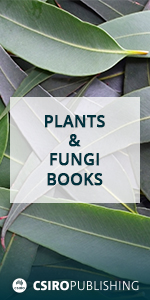Australian Journal of Botany
Volume 63
Number 7 2015
Nickel laterite deposits in tropical areas can disperse chromium into surrounding natural wetlands. This study investigates the species of macrophytes in such environment and the concentration of chromium in them. We identified five macrophytes with 37.1 to 180.8 mg kg–1 d.w. concentrations of Cr in the roots, and 10.5 to 23.7 mg kg–1 d.w. in the shoots. That information can be used to select macrophytes species for a constructed wetland.
The Grampians Pincushion Lily (Borya mirabilis) is close to extinction − only four colonies exist, all at one site. The species is 93−97% genetically uniform, polyploid and produces almost non-functional pollen. Although plants flower abundantly, they do not set seed naturally, and 450 artificial crosses resulted in only one (first known) seed for the species. Management plans should target cloning of all plants as the ex-situ collection does not currently capture the species’ full genetic diversity.
In this research we investigated seed dormancy of Grevillea species and the effects of Grevillea seed coat extracts on seed germination and seedling growth of several other plant species. Results showed that the seed coat was a major factor determining Grevillea seed dormancy, and removal of seed coat dramatically increased seed germination. Grevillea seed coat extracts reduced seed germination and seedling growth of other plants. We conclude that there is exogenous seed dormancy in Grevillea species and the chemical(s) in the seed coat is a major factor inhibiting seed germination.
Despite the widespread use of controlled ecological burning to manage heathland ecosystems in south-east Australia, we know little about how heathland vegetation changes in the long-term absence of fire. This study shows that the rate at which plant species drop out of heathlands in the absence of fire is probably slower than previously thought, and that different techniques used to study this rate can give different results. This has implications for how often land managers should burn heathlands and how post-fire recovery of heathland vegetation is measured.
The co-occurrence of species can be associated with phenological factors. The phenological behaviour of the co-occurring species Piper gaudichaudianum and Piper vicosanum were influenced by environmental variables and occurred mainly in the rainy season, but the sequential flowering and fruiting isolated them temporally from each other. Further, they were seen to display distinct reproductive strategies that seem to favour the maintenance of local populations.
Biological invasion is a major problem because it affects biodiversity on the planet, especially in fragmented landscapes such as occurs in South Brazil. An established population of the invasive Leucaena leucocephala in a seasonal forest in Brazil was shown to be invading other areas of the forest where disturbance had occurred. Here we propose management actions to eradicate this species before other areas of this forest fragment are invaded.
Most subalpine plant species in south-eastern Australia are resprouters, but several plant communities are dominated by seeders, potentially making them sensitive to the expected increase in fire frequency as global temperatures rise. Some seeder- and resprouter-dominated communities had not recovered 10 years after a fire in Kosciuszko National Park. Recovery is possibly a function of both the vegetation and external influences. We conclude that future fire management should be adaptive rather than prescriptive.
Insect galls are elegant models for the comprehension of plant developmental processes. Rosette galls induced by Pisphondylia brasiliensis on Guapira opposita buds are determined by different patterns of primary meristematic activity, with overproduction of neoformed buds and leafy projections. Also, the typical secondary growth in Nyctaginaceae occurs in multichambered galls, configuring the positive correlation between the number of larvae and the gall size.
In this study we examined the groundwater-dependency of sclerophyllous evergreen vegetation (wallum) on sand barriers in eastern Australia. The species displayed a range of physiological strategies in response to water relations, and these strategies overlapped among contrasting growth forms and habitats. Wetland vegetation in the lowest part of the landscape appeared to tolerate extreme fluctuations in water availability linked to a prevailing climatic pattern of variable and unreliable seasonal rainfall.




